Producing more with less
Transforming global food systems for a more sustainable and resilient future
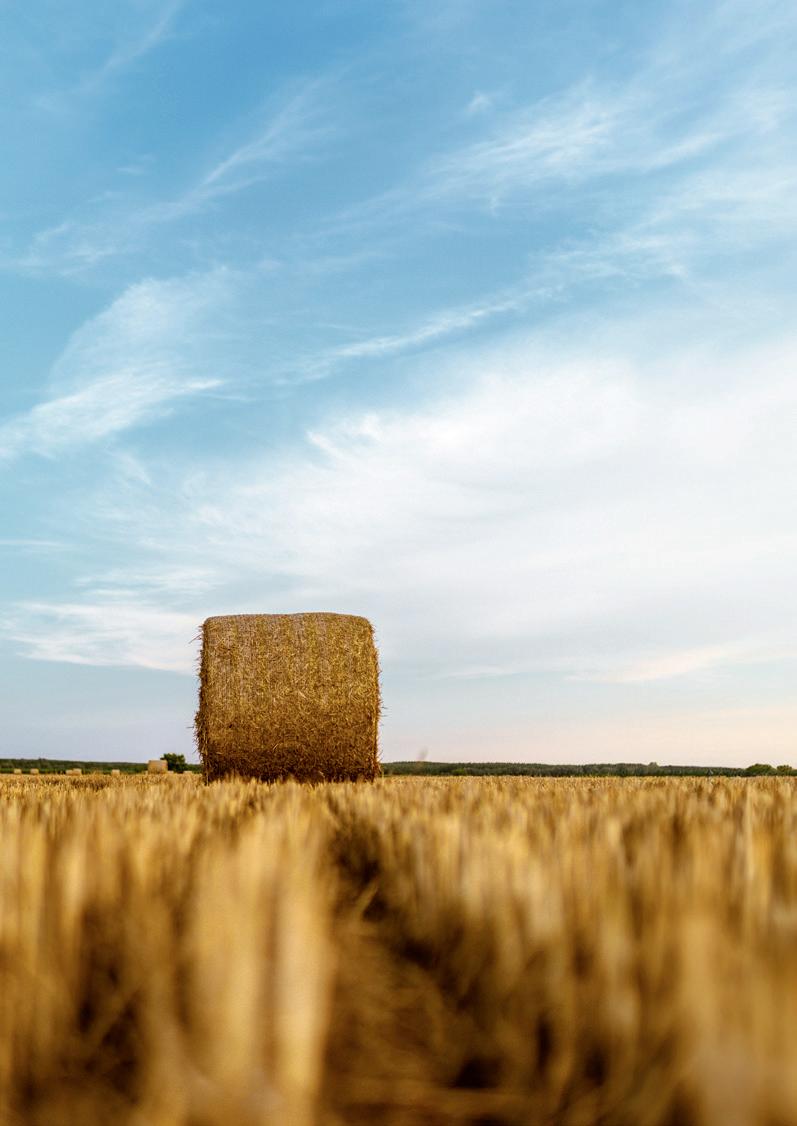
INSIDE THIS WHITE PAPER
Solutions for resource-efficient and data-driven agrifood systems
Partnerships and R&D to lower climate footprint
Improving biological conditions in agricultural areas through biodiversity restoration
Reducing dependence on fossil fuels through technologies such as biogas and pyrolysis
stateofgreen.com Connect. Inspire. Share. Think Denmark
WHITE PAPERS FOR A GREEN TRANSITION
PRODUCING MORE WITH LESS
Transforming global food systems for a more sustainable and resilient future
Version 1.0
December 2023
FRONT PAGE PHOTO
George Bakos, Unsplash
Editing: Henrik Wedel Sivertsen
EDITOR IN CHIEF
Magnus H. Mernild, mhm@stateofgreen.com
CONTENT PARTNER
The Danish Agriculture & Food Council
CONTRIBUTORS
The Danish Ministry of Industry, Business & Financial Affairs
The Danish Ministry of Environment
The Danish Ministry of Energy, Utilities & Climate
The Danish Agriculture & Food Council
The Danish Agricultural Agency
Danish Industry
SEGES Innovation
FOSS
FMC Agricultural Solutions A/S
Vestjyllands Andel
Ausumgaard
R&D Engineering & Automation
Arla Foods a.m.b.a.
DSE Test Solutions A/S
Grundfos
Better Insect Solutions
Enorm Biofactory
DLF
University of Copenhagen
DOWNLOAD THIS WHITE PAPER
Download this white paper and other related publications at www.stateofgreen.com/publications
FOR MORE INFORMATION
To order copies of this white paper or receive information about other related publications, please contact State of Green at info@stateofgreen.com
COPYRIGHT NOTICE
© Copyright State of Green 2023
COLOPHON
Unlocking nature’s own toolbox for growth and green transition
MORTEN BØDSKOV, MINISTER FOR INDUSTRY, BUSINESS AND FINANCIAL AFFAIRS
By 2050 the global population is expected to reach 10 billion. This will lead to growing energy and resource demands as well as increased pressure on land usage. On top of all of this, we need to handle the challenges of climate change, environmental degradation and biodiversity loss.
These issues dictate the future – maybe clearest when it comes to food production: we need to make more with less.
This means that we need to do things differently. We need to change business as usual and provide the best possible feeding ground for budding industries and new technologies. For instance by grabbing the opportunities in biosolutions. Solutions that allow societies access to nature’s own toolbox and spur society-wide innovation.
Danish businesses are cutting-edge when it comes to biosolutions. As a well-established research-based industry with a strong international engagement, the Danish biosolutions cluster provides a breadth of ways to initiate and accelerate the green transition across industries. Not least, when it comes to more sustainable food production, biorefining and precision agriculture.
As a small country with around 60 percent of our land area dedicated to agriculture, the impact on our society is large. Denmark is determined to speed up initiatives, to transform food production and balance its impact on the surrounding environment. Danish startups, universities, and established businesses within the food cluster are among the best in the world and recognized for an innovative mindset and data-driven approach.
 Morten Bødskov Minister for Industry, Business and Financial Affairs
Morten Bødskov Minister for Industry, Business and Financial Affairs
This gives Denmark an advantageous position to push the needle for one of the world’s most emission-heavy sectors. To push the needle for a more sustainable world, where we make more with less.
Danish companies and authorities are already making a global impact through research, innovation and technology development that builds upon the notion of public-private climate action.
Trustful collaboration across sectors and industries has long been a key ingredient in the Danish way of innovating and doing business. One such example is Denmark’s 14 industry-specific Climate Partnerships.
These partnerships have been instrumental in showing a way forward on everything from energy and finance to agriculture and food. A way forward that leads to a more sustainable world, but one that also finds value, export possibilities, job creation and growth opportunities for Danish businesses. A way forward that can actually have a real and lasting impact on how we do things.
For agrifood, the model underscores the value of cooperating across public and private, across sectors and companies to ensure that farmers and food companies have the best possible foundation to meet the challenges of the future.
This white paper presents insights, visions, and tangible solutions. I hope you will look to Denmark for inspiration on the new solutions addressing the global challenges to optimize productivity and deliver sustainable food production.
Enjoy reading.
3 FOREWORD
Danish solutions to global challenges
MERETE JUHL, CEO OF THE DANISH AGRICULTURE AND FOOD COUNCIL
Food is a fundamental part of our lives and plays an essential part in our culture and traditions. As the world’s population increases, demand for food will similarly rise.
With this white paper, we wish to present the world with our best examples on how we can meet the growing demand for food while producing quality food with the least possible impact on our planet. The global food systems need to be transformed in a more sustainable direction, and we insist on being part of the solution.
For many years, the Danish food industry has provided the world with food and food technology of a very high quality. We ensure that food is on the table in both Denmark and abroad. We deliver inputs and databased solutions that are fundamental for improving production. And at the end of the value chain our residual products are important raw materials for the production of green energy.
However, we need to do more than that. Food production leaves an impact on climate, environment, biodiversity, and natural resources. Food production of the future is therefore not just about producing more food. Political requirements
and consumers’ demand will force us to rethink and transform the current food systems. Every day we need to get a little bit better.
This is a hard task for societies and for the individual farmer and company. We cannot solve the challenges in one fell swoop. Securing stable, competitive food production with minimal impact on our ecosystem, requires joint efforts, large investments, and hard work. In Denmark, we have a long experience of success when the private and public sector work together. We know that investments in solutions today are investments in the future.
In this white paper, we present solutions that have created value in Denmark. However, in order for them to reach their full potential as climate mitigating and adapting technologies, they must be shared with the rest of the world. Highlighting state-of-the art case examples from Denmark, this white paper acts as a blueprint, demonstrating how to maximize the potentials of existing technologies and transform our food system towards a more sustainable future.
I hope you will be inspired.
 Merete Juhl CEO of the Danish Agriculture and Food Council
Merete Juhl CEO of the Danish Agriculture and Food Council
FOREWORD 4
Executive summary
From agrarian economy to a modern food industry
Denmark’s legacy as a farming country is evident in both the layout of the land, its institutions, and its culture. Denmark is home to one of the world’s oldest agricultural universities, agricultural schools, and innovation and consulting centers covering the entire production chain. Today, 61 percent of Denmark’s land area is used for agricultural purposes, and agrifood plays a big role in the Danish economy. Danish agrifood products are sought after worldwide for their quality rooted in extensive production knowhow, energy-efficiency, and high standards for food production. The regulatory setup around the Danish agrifood sector is based on an enduring tradition of both regulating and collaborating with the agrifood sector.
The agrifood cluster is a major contributor to the Danish economy with an annual contribution to GDP of DKK 70 billion and more than 180,000 jobs in Denmark are related to the agrifood cluster. In 2022, agrifood exports reached a record high of DKK 196 billion, equivalent to 24 percent of the total Danish export of goods . The Danish agrifood cluster supplies food both at home and abroad from finished products to integrated contributions to other value chains. However, the agrifood cluster also greatly impacts Denmark’s CO2 emissions. Emissions from the sector add up to 15.9 mio. tonnes of CO₂e, corresponding to 34.4 percent of Denmark’s aggregated emissions measured in CO2e. This equals a 32 percent emission reduction compared to 1990 levels.
Intensive farming further impacts the surrounding nature in terms of biodiversity, pollution, and degradation of soil. With a projected 60 percent increase in global food demand by 2050, it is evident
that we need to use resources more efficiently and implement solutions and new technology to transform the agricultural sector. In 2019, the Danish food sector committed to achieving net-zero emissions by 2050. Initiatives range from improving energy efficiency in food production facilities to incentivising farmers to reduce emissions. The Danish government has set binding reduction targets for CO₂e emissions in the agriculture and forestry sector, with significant progress made in reducing emissions while increasing production.
Innovation and collaboration must lead the way. Reaching a successful, balanced transition requires action from both the public and private sectors. Recognising the pivotal role of food production for the prosperity and well-being of the world’s population alongside its challenges, this white paper showcases Danish solutions to the challenges of decarbonising the agrifood cluster. Public-private partnerships are a long-standing tradition in Denmark, and a key factor in fast, socially just action towards reaching the climate goals. The Danish examples show that there is a large potential for developing more sustainable farming techniques when we work together.
Dual approach for adaptation and mitigation
Meeting the ambitious targets set for the agrifood cluster, the Danish Government requires the implementation of mitigation efforts as well as strategies for adaptation. As such, the Danish agrifood cluster is continuously working to improve and adapt the production and import of agricultural produce to meet the challenges.
5 EXECUTIVE SUMMARY
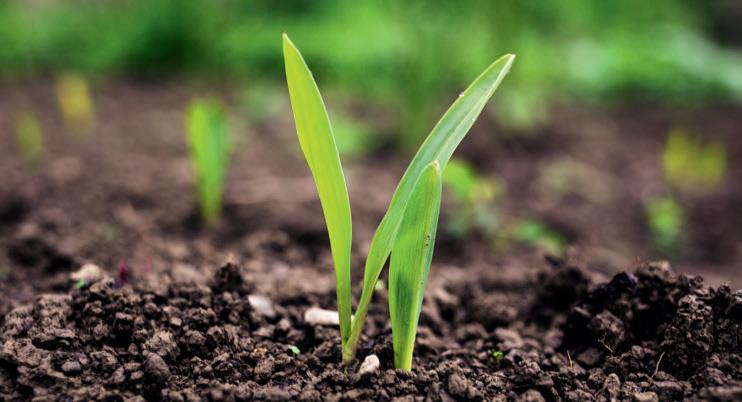
Climate change is altering the landscape of global food production, necessitating adaptability. Denmark's food sector is at the forefront of embracing resilient practices, such as implementing technologies to navigate shifting weather patterns and ensuring that resources are used smarter and more efficiently, limiting waste from all links of the value chains. Resource efficiency is a cornerstone of Danish food production. The Danish approach to food production is "producing more with less". Focus is especially on reducing the use of critical resources such as energy, water, and other scarce resources. Collaborative efforts between government, industry, and research institutions, combined with targeted research and development, have demonstrated the possibility of increased productivity while minimising environmental impact. Meanwhile, innovative technological breakthroughs within bio solutions offer new opportunities for optimising productivity.
The Intergovernmental Panel on Climate Change (IPCC) has highlighted agrifood systems' significant climate change mitigation potential. Denmark's food sector is resolutely committed to climate mitigation and emission reduction. Initiatives range from enhancing energy efficiency in production facilities to incentivising farmers to reduce emissions. Government-imposed targets underscore the sector's determination, resulting in substantial emission reductions without compromising productivity. Additionally, reducing reliance on fossil fuels through biorefining and the adoption of biogas, pyrolysis, and biomass utilisation is a priority for Denmark's food sector. With a focus on optimised farming practices and strong public-private collaborations, the sector is poised to lead the transition toward renewable energy sources. Other initiatives such as rewetting peatlands and creating mini
wetlands are examples of approaches to reduce greenhouse gas emissions while making more space for nature and biodiversity.
Making the most of data
Progress in the Danish food sector is greatly attributed to close cooperation between industry, government, and research institutions. Data plays a critical role in enhancing the efficiency and sustainability of food production. The Danish food sector boasts a robust digital infrastructure and has been collecting and sharing data for decades. This enables innovation and precision in all phases of the agrifood system. R&D activities are largely seen as a collective endeavor, creating a close link from research to practice and day-to-day farming which enables the transformative processes.
Transforming agrifood systems worldwide is a crucial competency in the global green transition. From known resource and energy-efficient practices to new ground-breaking technology, the Danish agrifood cluster aims to continue leading the way globally, produce more resilient food products with a lower climate and environmental footprint, and drive the transition towards climate neutrality by 2050.
The Danish Government has set a binding reduction target for CO₂e emissions for the agriculture and forestry sector for 55-65% in 2030 compared to 1990 levels. This equals a reduction of 5.1-7.1 million tonnes CO₂e.
EXECUTIVE SUMMARY 6
7
Chapter 1: Turning global momentum into green commitment 8 Chapter 2: A data-driven green transition in agrifood 10 Chapter 3: Making space for both agriculture and biodiversity 14 Chapter 4: Towards food production with lower climate impact 18 Chapter 5: Contributions to the green energy transition 22 Chapter 6: Solutions for resource-efficient agrifood systems 26 Chapter 7: Adapting food production to a changing climate 32
Index
Turning global momentum into green commitment
Agrifood systems are a crucial axis of the global green transition. Strained by climate change and a growing world population, we must hone in on how agrifood can contribute to sustainable societies. This is a key task for the Danish agrifood cluster.
Agrifood systems cover a wide range of activities in the primary production of food and non-food agricultural products, as well as storage, transportation, processing, distribution, disposal, and consumption. All links in the value chain are pressured by the rapidly growing world population and climate change. By 2050, we will be close to 10 billion people on Earth. The demand for food is projected to increase by 60 percent. A growing middle class will expect high-quality, sustainable products. As the changing climate hinders food production in many places, regions with better prerequisites, like Denmark, will have a responsibility to meet the global demand for food supply - all while considering how agricultural production impacts greenhouse gas emissions, environment, and biodiversity.
Global momentum
Agrifood systems represent a promising area of action. The IPCC highlights the significant climate change mitigation potential of agrifood systems. Mitigation options, such as sustainable intensification in agriculture, plant-based alternatives and less food loss and waste make agrifood
systems a crucial part of the solution to climate and environmental challenges. Pursuing a sustainable approach to agrifood also promotes food security and increases the resilience of farmers and communities most impacted by climate change.
Sharing Danish experiences
Denmark has long been among the world leaders in safe and efficient agriculture and food production. Across the agrifood value chain, Danish solutions can contribute to solving the crises of the climate and the environment. Both at home and abroad. From known resource- and energy efficient practices, to new ground-breaking technology, the Danish agrifood cluster aims to continue leading the way globally. Aligning with national climate policies and the UN’s Sustainable Development Goals, it has committed itself to becoming climate-neutral by 2050. Sowing the seeds for success by engaging in cross-sectoral partnerships, the Danish agrifood cluster is well-positioned to realise the ambition.
8 CHAPTER 1

9 PRODUCING MORE WITH LESS
Photo credit: Food Nation & Niels Hougaard
A data-driven green transition in agrifood
Denmark’s agrifood cluster is uniquely positioned to collect, exploit, and share data in the food production process. Purposeful measurement is crucial to reducing waste and increasing production yields throughout the value chain.
Agriculture is facing major changes in the coming years. But to change, you must know how to focus your efforts. Data plays a key role in outlining possible starting points, understanding core challenges, making forecasts, and developing new production methods. Applying those insights lets both producers and decision-makers make informed choices about how to build frameworks for resource-efficient production.
The Danish data and innovation infrastructure
The digital infrastructure within the Danish agrifood cluster provides fruitful conditions for a data-driven transformation. For decades, the agrifood industry has been collecting data to minimise on-farm wastage and to support development and innovation. This has resulted in vast databases within various farming sectors. Denmark’s farmers own comprehensive databases of agricultural statistics based on agriculture’s own innovation centre, SEGES Innovation. The innovation centre gathers all innovation projects, production management applications, and all specialists under one roof.
Denmark’s unique innovation model builds on a historically strong set-up involving one of the world’s oldest agricultural universities, agricultural schools, and innovation and consulting centres covering the entire production chain. The benefits of this setup for data and innovation are twofold. First, the farmers themselves have significant ownership of the biggest undertakings in Denmark’s food
production systems. This provides great opportunities for sharing data, aiding both research and production. Second, by having the different actors and institutions so closely connected, the distance from research to practice is short, enabling the transformative processes.
Progressive transformation on a solid foundation
In Denmark, the data-driven transformation is well underway. The first step of generating an overview of the challenge ahead is already complete. According to the Danish Climate Status and Projection 2023, the total emissions from the Danish agricultural sector was 14.48 million tonnes of CO2 equivalents in 2021, equal to 30 percent of the total Danish emissions that year. The figure also considers the energy consumption of the agricultural sector. This gives the sector a north star to lead their transformative efforts towards reaching national goals.
Additionally, in recent years, data in large quantities has become accessible through new technologies creating new opportunities for companies. From measuring the individual cow’s feed intake to calculating farm-specific climate gas emissions from crops and livestock production, the Danish agrifood cluster is making the most of the possibilities of data. Together with its stakeholders, it will continue to utilise data to produce more resilient food products with a lower climate and environmental footprint and drive the transition towards climate neutrality by 2050.
10 CHAPTER 2
The Danish agrifood cluster
All parts of the Danish agrifood cluster are closely connected. Players across the entire value chain are working in tandem to move the needle on green transition at home as well as globally.
Processing and minimising waste
Husbandry: Pig, poultry, dairy and beef production
Plant cultivation
Fisheries
Breeding new genes and new plants
Agro stables
Data and management Ingredients and enzymes
New protein sources
Agro machinery
11 PRODUCING MORE WITH LESS

ESGreen Tool: Measuring emissions and potentials
As part of Denmark's national climate targets, the Danish agricultural and forestry sector must reduce its greenhouse gas emissions by 55-65 percent by 2030 compared to 1990 levels. This ambitious target requires that the individual farmer has a full overview of his emissions as well as reduction potentials.
In 2022, SEGES Innovation introduced the first version of the digital application, ESGreen Tool. The tool can be utilised to calculate farm-specific climate gas emissions from crop and livestock production based on the data available at the individual farm. To generate a trustworthy measurement, the calculations are modelled on international standards and the guidelines of the IPCC. Considering the crops, soil types, fertiliser usage, number of livestock etc., the tool calculates the emissions of the three climate gases CO₂, CH4 and N₂O on a scope 1, 2 and 3 level.
Calculations of climate gas emissions based on the farmer’s own data has proven to be an efficient way to open the farmer’s eyes to the different climate emissions from his or her production. In addition, the tool has a ‘what-if’ functionality to investigate scenarios for which measures have the highest emissions reduction potential. This is of course relevant in relation to the cost and ease of implementation.
ESGreen Tool is also an innovative way of future-proofing agriculture. The results from the tool will be essential input to the ESG reporting that most – if not all – farmers soon will be providing to e.g., financial institutions.
CONTRIBUTORS
CASES 12
SEGES Innovation, The Danish Agricultural Agency
Graphic design: SEGES Innovation
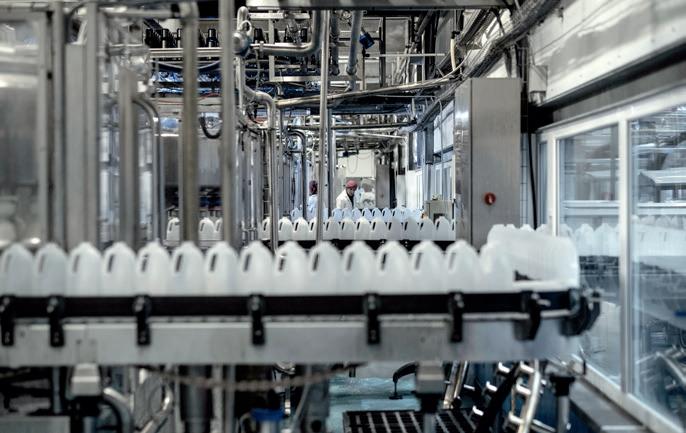
Empowering sustainability with analytical solutions
Today, one-third of all food ends up as waste, hence food waste is responsible for 6 percent of the global greenhouse gas emissions. As such, mitigating the climate impact of food production hinges on implementing improved tools and measures to reduce food waste and optimise production processes along the supply chains.
FOSS supports the world’s top 100 food companies and 40,000 others, specialising in advanced measuring and digital solutions tailored for agriculture and food production. Analytical solutions impacting diverse sectors such as dairy, grain, oilseed, feed, wine, beer, meat, sugar, plant-based products, and food laboratories, empower businesses to transform measurements into actionable insights. These insights drive intelligent, data-informed production processes that curtail waste, boost yields, and elevate food safety and quality standards.
By enhancing production efficiency and minimising waste and food loss, FOSS equips its customers to generate more food from finite resources. This achievement is facilitated through precise measurement and calculation, optimising harvest timing, and overseeing various production processes. Furthermore, data analysis capabilities enable the proactive management of food safety concerns, thereby reducing the necessity to dispose of significant food quantities.
FOSS’ analytical solutions for production optimisation have been proven to yield the following efficiency improvements:
• Butter production optimisation: 0.5%
• Cheese production optimisation: 0.4%
• Powdered milk production optimisation: 1%
• Greek yoghurt and cream cheese production optimisation: 4.5%
13 CASES
CONTRIBUTORS FOSS Photo credit: FOSS
Making space for both agriculture and biodiversity
Making space for both food production and natural wildlife is a balancing act for a small country like Denmark. Increasing the productivity of agricultural production has the potential to free land area and improve biological conditions in agricultural areas through biodiversity restoration.
As a society, we face several challenges in the aim of protecting the environment, reducing greenhouse gas emissions, and securing that means used for pest and disease control are sustainable and non-polluting. To achieve this, we must find new and more innovative solutions. Danish businesses are cutting-edge at biosolutions (e.g., biocontrol products based on pheromones and microorganism), biorefining, precision agriculture, and mini wetlands. Regulation has been used to support and drive the innovations.
With agriculture in close proximity to water bodies, protecting the surrounding environment from fertiliser leaching has been a political priority in Denmark with a slew of regulatory measures since the 1980s. It is a strategic aim for Denmark to achieve record-low negative impacts from plant protection products use. The goal is to use plant protection products as little as possible, and to ensure that the plant protection products that are used have the lowest possible loads. Denmark works actively in the EU to promote the authorisation of biocontrol products as an alternative to chemical plant protection products to benefit conventional as well as organic farmers.
Making agriculture more sustainable also means growing more with less. The demand for agricultural resources drives up the demand for cropland, potentially at the cost of deforestation and the depletion of natural resources. Biocontrol products are a way to boost yields without in-
creasing the acreage by enhancing the biological processes and improving crop efficiency. Utilising naturally occurring microbes and molecules boosts the uptake of phosphorus and nitrogen to make better use of the available nutrients. An increase in productivity by using microbial inoculants can lead to environmental benefits that add to the sustainability of the crops being grown.
Rewetting peatland is another solution to reduce greenhouse gas emissions. In Denmark, the political ambition is to take out up to 100,000 hectares of carbon-rich soils from agricultural production for rewetting by 2030. The 100,000 hectares include nearby surrounding areas and extensification. As of 2023, the involved authorities have more than 30,000 hectares in their pipeline.
The restoration of wet peatlands is a way to reestablish biodiversity and important ecosystem services such as sequestration and carbon storage, water, and nutrient retention, as well as securing habitats for rare species. Rewetting can be done by removing the drain and thereby raising the water level within the project area, or by returning a watercourse to its meandering course, thereby slowing the current speed of the water. This makes water levels rise, allowing it to flood in a project area. In general, the peatlands are often lowlands as well, and therefore naturally will have a tendency of being a wet habitat.
14 CHAPTER 3
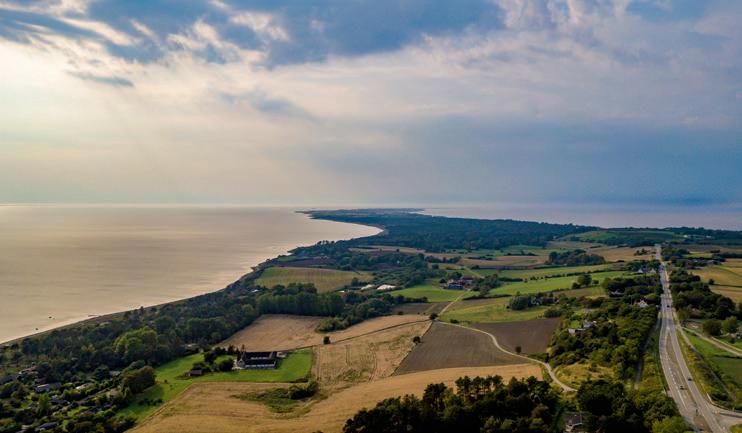
Decoupling production volume from environmental footprint
Source: DCE-rapport nr. 451, DCE: Agriculture (http://envs.au.dk), Danmarks Statistiks Nationalregnskab, EIONET.
Central Data Repository: A. National emission inventories (CLRTAP).
140 120 100 80 60 40 20 0 1990 Production volume Phosphorus surplus Nitrogen - emissions from agricultural sector Ammonia loss 2000 2010 2020 15 PRODUCING MORE WITH LESS

Pheromones protect crops naturally against pests
Intensive utilisation of habitats, soils and water resources in the agricultural industry undercuts our efforts to develop sustainable food systems and to reduce carbon emissions into the atmosphere. Another barrier to accelerating a sustainable development has until now been the difficult access to markets for biocontrol products where pheromones until now have been too expensive for usage in most agriculture.
The Danish based FMC European Innovation Center has developed a manufacturing technology based on yeast fermentation, making it possible to produce insect pheromones at a cost suitable for agriculture at large. This new type of biocontrol products protecting the crops benefit the industry worker producing them and the farm worker applying them, as well as biodiversity in the field. Unlike traditional insecticides that control insect pests by disrupting their mating, EIC-developed pheromones are natural compounds released by insects in small quantities to attract a mating partner of the same species. This leaves bees and other beneficial insects thriving and poses little risk of exposure to other animals or humans.
Field trials have demonstrated that insect pheromones can be used to control pests in row crops effectively, reducing the consumption of conventional insecticides. In field trials in rice in Bangladesh and India, pheromone-based insect control also increased yields by up to 25 percent. Used as part of an integrated pest management regime, pheromones give farmers a new way of controlling pests in row crops with a significant reduction in human and ecological toxicity, according to a life cycle assessment study of pheromones.
The difficult market access to biocontrol products is amongst others due to a lengthy approval process for bio-based products at EU and member state level. This is particularly the case when it comes to biological plant protection products where the complex structure of the approval system can constitute a challenge. Denmark is pushing for expedited evaluating of low-risk biotechnological climate solutions as active substances.
CASES 16
How insects like moths attract a mating partner Female

How we apply pheromone to disrupt their mating
Pheromone plume Pheromone formulation
Male Male Female
17 CASES CONTRIBUTORS FMC Agricultural Solutions A/S LOCATION Among others,
India and Brazil.
Bangladesh,
Towards food production with lower climate impact
The urgent need for a green transition of global agrifood systems is clear. Denmark’s agrifood cluster exemplifies the innovation necessary to lower the climate impact of agrifood systems.
Efforts in Denmark's agrifood cluster can be a source of inspiration and solutions in moving global agrifood systems towards production with lower climate impact. Danish agriculture performs well in international comparisons of production processes with a reduced carbon footprint. In 2020, the World Resources Institute showed that Denmark is among the most climate-efficient countries in the world when it comes to production of pork and dairy products. The Danish agrifood cluster is proof that reduced emissions and increased production can go hand in hand. In total, the Danish agrifood cluster has reduced its emissions with 25 percent from 1990 – 2020, while producing 28 percent more. It is a reduction of the climate footprint per produced unit by 31 percent. This is notably attributable to a high feed conversion ratio and the subsequent lower discharges from the feed production process. Most of the emission reductions were seen in the period between 1990 – 2005.
The study from WRI does not include import of feed, because the calculation model is based on the territorial principle, which includes emissions linked to production and consumption within Denmark's borders. When the territorial principle is applied, it means that import of soy is not included in the calculation. However, the climate effect of Danish solutions that are exported is not included either, even though these displace many tonnes of CO2e globally in their lifetime.
The calculation model is important to factor in when aiming to reduce the climate impact of agrifood production. While Danish husbandry production still imports soy as a feed ingredient, many stakeholders within the Danish value chain are participating in the Danish Alliance on Responsible Soy. As soy ranks amongst the commodities mostly linked to deforestation and conversion of other valuable natural ecosystems, the alliance is committed to import and utilise 100 percent responsible, deforestation-free and conversion-free
soy by 2025. Annual assessments undertaken by the University of Copenhagen are commissioned by ministries to track progress towards this target.
At the same time, it is important to find lower-impact solutions for producing protein that can be used globally. Biorefining of grass is an example of cascade utilisation. Through biorefining, the grass protein can be made digestible for non-grass-eating animals. This allows the farmer to import feed more locally and exemplifies an innovative approach that allows for continued food production with decreased carbon emissions. Researchers are working on developing a grass protein for human food products, too. The ambition is to optimise the process so the area required can be cut in half.
Ambitions, solutions and binding commitments
In 2019, the Danish agrifood cluster committed itself to an ambition of reaching climate neutrality in 2050. From improving the energy efficiency of the buildings that house agrifood production to providing financial incentive models for farmers to reduce emissions and investigating the potentials of methane capture, the cluster is exploring every potential avenue from implementation of known technologies to development of novel solutions.
The cluster is currently working with solutions like frequent manure removal, reduction requirements for cattle and a development track with a focus on new feed additives and manure handling. All the solutions are working towards lowering the climate impact of food production.
The agrifood cluster also participated in the Danish Climate Partnerships in 2020 and presented 24 concrete recommendations to the Danish Government on how to create a viable framework for the green transition of the agrifood sector.
18 CHAPTER 4
Increasing production volume while lowering climate footprint
In 2020, the World Resources Institute named Denmark amongst the world's most climate-efficient countries within dairy as well as pig production.
Production +28% Climate -25% 1990 = 100 2020 19 PRODUCING MORE WITH LESS
PROCESS OVERVIEW: BIOREFINING OF GRASS
Harvest of grass
Compression Fermentation
Centrifugation Protein paste
Pig and poultry feed
Press cake
Cattle feed
Locally produced protein alternative to soy
Brown juice
Production of biogas
The agricultural company Vestjyllands Andel extracts protein from grass at Denmark’s first farm plant for biorefining of grass, Ausumgaard, in Northwest Jutland. The grass protein has the potential to replace imported soy from China and South America.
Refined grass is a manageable and locally produced source of protein for animal feed, where all residual production can be used for biogas to limit waste. When the new feed is launched, it will become profitable and thus attractive for plant breeders and farms to convert grain fields to grass. This will lower the sector’s climate footprint. Grasslands store more carbon in the soil and loose less nitrate to the aquatic environment compared to annual grain and seed crops. By using grass for protein production, we avoid the large import of soy as well as achieve climate and environmental benefits by growing more grass.
The farm's new, decentralised biorefinery will function as a prototype plant and inspiration for other farms and investors. Now, 1.5 tonnes of pure protein is produced per hectare over a season. The estimated potential is that they can produce 700-800 kg of grass protein per hectare more than the current achievements.
CONTRIBUTORS
Vestjyllands Andel
Ausumgaard
R&D Engineering & Automation
SEGES Innovation
LOCATION
Denmark
CASES 20

Rewarding farmers to motivate climate initiatives
The farmer-owned dairy cooperative Arla creates incentives for the individual farmer to work with sustainability activities by paying out a monthly reward based on a point system. This means that the Arla farmers who take most action receive the highest price for their milk.
The cooperative has introduced a science and points-based model that makes it possible for farmers to earn up to 80 points. Based on which measures that make the largest impact, a system with 19 point-giving levers – such as feed and protein efficiency, manure handling, sustainable soy, renewable electricity, and land use – is used for rewarding the farmers’ work with climate and sustainability.
For each point the farmers earn, they receive EUR 0.03 per kilo milk. Additionally, they receive EUR 0.01 per kilo milk for submitting Climate Check data.
Arla has earmarked up to EUR 500 million each year to reward and motivate farmers. The size of the incentive depends on the individual farmer's effort. Based on the current points score, EUR 300 million is currently activated on an annual basis, meaning that Arla will pay a total of at least EUR 2.2 billion for sustainability activities on the farm until the end of 2030. However, the amount is expected to increase as farmers, motivated by the incentive, make further climate improvements.
An average Arla farmer with an annual milk production of 1.6 million kilo milk can look forward to receiving close to EUR 40,000 a year, based on the current average point score of Arla farmers.
21 CASES
CONTRIBUTORS Arla Foods a.m.b.a.
Photo credit: Food Nation & Niels Hougaard
Contributions to the green energy transition
The activities of the Danish agrifood cluster does not only yield high quality food products for millions of people, they also hold the potential to reduce dependence on fossil fuels through technologies such as biogas and pyrolysis.
The Danish agrifood cluster produces green solutions for more than just the food industry. While conversations about the green energy transition tend to focus on the energy sector, efforts within the agrifood sector also play an essential role in creating more sustainable energy and production systems. Besides optimising farming procedures to reduce greenhouse gas emissions and increasing carbon storage in the soil, the agrifood sector can aid the green transition by contributing with biomass for energy production, building materials and bio-based materials.
Phasing out fossil resources increases demand for biomass from forestry and agriculture. There are huge biological residues from food companies, side streams from food production, landscape management etcetera that can be utilised for energy and fertiliser production, which can serve as a transitioning tool away from fossil energy on the path to renewable energy sources in a time when conditions for energy security are challenged. The biomass we grow must be used for as many purposes as possible, including food, construction, materials, energy - and finally carbon storage. Thus, a central task in the green transition is to optimise the utilisation of photosynthesis and transform biomass to biobased solutions.
The contribution can be made through a range of processes, such as:
• Utilising straw for energy purposes at the bottom of the value pyramid.
• Production of biogas, whereby fossil natural gas is replaced.
• Utilising pyrolysis, producing energy for various Power-to-X purposes, while stabilising the carbon content of the biomass input.
Utilising biogas
In terms of biogas, 30 percent of the manure from the livestock sector in Denmark is processed in a biogas plant – a rate that is among the highest in the world. The Danish biogas production has in 2023 substituted 40 percent of the natural gas consumption and is expected to totally substitute fossil natural gas by 2030. The biogas production is mainly based on livestock manure and residues from industry, households and agriculture. In turn, the sector’s contribution to biogas production enables more sustainable agricultural practices by reducing the climate footprint of production and converting livestock manure and organic waste into fertiliser.
Working together for solutions
The potential of the Danish agrifood cluster’s contribution is already reflected in legislation and sectoral efforts. Finding and optimising new ways of utilising agricultural residues required a heavy R&D effort. In Denmark, the development and deployment of these measures occur in close collaboration between the sector, universities, and authorities. The commitment of all parties is vital to ensure viable conditions for financing, development and practical implementation.
22 CHAPTER 5

23 PRODUCING MORE WITH LESS
The Danish biogas plants play a central role in the handling of food waste, residual products and livestock manure. The biogas plants ensure that nutrients in waste and residual products are recycled as fertiliser for agriculture. At the same time, the energy content of the biomasses is utilised for biogas, which displaces fossil fuel.
Photo credit: Biogas Danmark
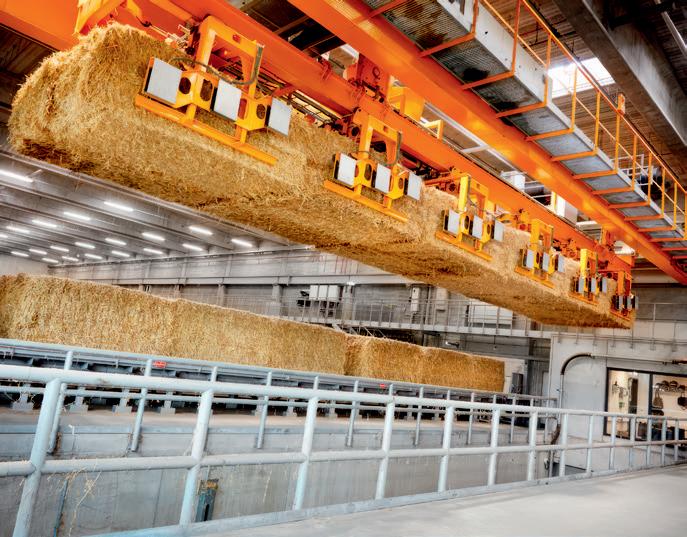
Making every straw count
Use of straw from wheat and barley for energy is an almost climate neutral energy solution. With more than 100 energy plants utilising straw for heat or heat and power, the technology is widely used across Denmark. For this we annually collect about 1.4 million tonnes of straw for energy. By using straw for energy, we can reduce dependency of fossil oil or gas in the energy production. The CO2 emission from coal is approximately 100 kg/ GJ, which means that by burning a load of straw instead of coal with the same energy content, CO2 emissions are reduced by approximately 17 tonnes.
Using straw for energy requires special equipment that Danish suppliers are experts in. An example is DSE Test Solutions A/S. The company produces advanced moisture meters. The technology contributes to more efficient processing of biomass in power plants, dehydration plants and biomass processing plants all over the world.
In today’s world, knowing the moisture value of biomass is of the outmost importance to process the biomass most effectively and thus increase the yield, may it be cellulossic ethanol production, dehydration of animal feed, energy production, pellet production or other applications. The microwave-based moisture meters of DSE can be used to measure in all organic materials.
CONTRIBUTORS
DSE Test Solutions A/S
LOCATION
Norway, Sweden, Finland, UK, Germany, Romania, Hungary, Spain, Italy, France, Brazil, Australia, New Zealand and USA
CASES 24
Microwave-based moisture meters in action at the Lisbjerg plant: When measuring with microwaves you are in contact with a lot of material instead of just a little sample. You get the measuring result at once with a very accurate result.

25 PRODUCING MORE WITH LESS
Solutions for resourceefficient agrifood systems
Denmark’s approach to food production is centered around the concept of "producing more with less". This mantra has become increasingly important as the world faces a growing food crisis, highlighting the need to utilise resources more efficiently.
The global challenges facing the world are interrelated: the climate crisis, environmental degradation and food security all concern the pressure put on the world’s resources. In a world where the population is growing and the demand for meat and other proteins are increasing year by year, production cannot disregard nature, the environment or animal welfare. The UN’s Food and Agriculture Organization have identified three necessary focus areas if we are to make the intensive production more sustainable:
• Reduce the impact on climate, environment and biodiversity
• Reduce the necessary input
• Recirculate the agro-industrial by-products
Through continued development of a more sustainable intensive food production and new technology, we can create jobs and economic growth, protect nature, and provide answers to some of the major global challenges that we all face.
Data leads the way
Denmark has one of the most resource-efficient food producing sectors in the world. The Danish agrifood cluster has demonstrated that increased food production is possible whilst at the same time reducing its impact on the environment and the climate. Additionally, the Danish agrifood cluster is focused on reducing the use of critical resources such as energy, water, and other scarce resources. Collecting and using data to monitor the resource use is key to making the necessary reductions. In some cases, Danish producers use 15 percent less feed than the global average, thus showcasing how focusing on resource efficiency can result in producing more food without increasing the pressure on land and water. Focussing on the development of solid protein alternatives is also a way to reduce the land, environmental and climate footprint.
Results from research and partnerships
Progress in the Danish food sector is also attributed to a close cooperation between government, industry, and research institutions. With targeted R&D, Danish companies have been able to increase productivity, thereby reducing the environmental footprint of production.
The Danish Partnership for Resource and Water-Efficient Industrial Food Production (DRIP) is an example of a public-private partnership that enables the deployment of science-based solutions decreasing the pressure on resources by the industry. DRIP focuses on water efficiency in the food industry - one of the largest water-consuming industries in Denmark and globally.
The partnership gathers food sector companies, technology providers, universities, and research and technology organisations to produce more food with less water without compromising product quality and food safety. The partnership is realised due to a deep commitment on behalf of the Danish authorities, who monitor and assist with safety aspects.
As a tangible result of the tie-up, participating companies have realised water savings of more than 900,000 m3/yearly. This corresponds to 20 percent of the water consumption of the participating food companies or the annual water consumption of 23,000 people.
In 2020, the World Resources Institute named Denmark amongst the world’s most climate-efficient countries within dairy as well as pig production.
26 CHAPTER 6

27 PRODUCING MORE WITH LESS
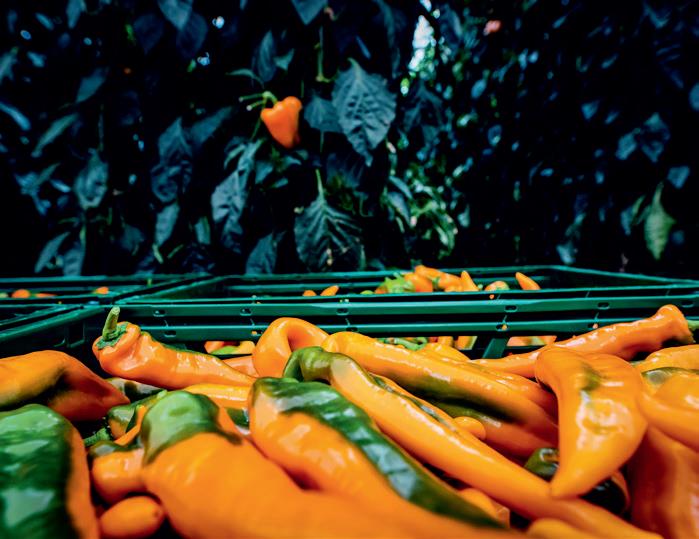
Biostimulants help farmers save water
As climate change leads to warmer temperatures and more droughts, water scarcity poses an increasing challenge to agricultural productivity. In areas lacking conventional or sufficient water resources, there is a need for new water management practices to ensure healthy crops without depleting precious water resources. Biostimulants are naturally derived products that can help improve plants’ absorption of water and nutrients in water-stressed environments, giving farmers the possibility to produce higher yields even with less water.
Biostimulants contain biological or biologically derived substances or microorganisms that can stimulate plant and soil health. A healthy plant can defend itself better from stress factors such as pests or harsh environmental conditions. Further, biostimulants can boost soil health by improving organic matter content, soil structure, and beneficial soil microbes. For plants, this can mean better root development and uptake of nutrients and water. Seaweed-based biostimulants such as Seamac® Rhizo, which contains a unique blend of amino acids, nutrients, and seaweed, has proven to boost yield of water-stressed crops.
A study of the Seamac® Rhizo biostimulant applied to a range of water-stressed crops, including tomatoes, grapes, melons, peppers, and lettuce in Cartagena, Spain, showed that Seamac® Rhizo can help farmers stimulate agricultural productivity with less water and improve overall plant health by increasing the efficiency of nutrient and water uptake in plant root system.
CASES 28
CONTRIBUTORS FMC Agricultural Solutions A/S
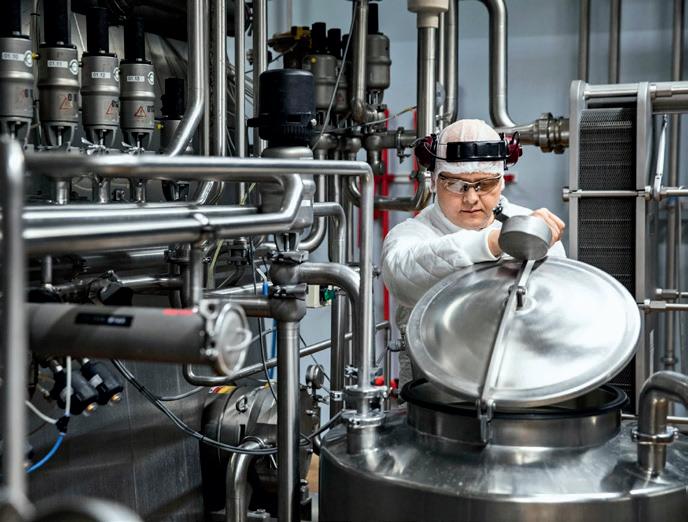
Intelligent pumps reduce energy consumption
The global dairy company Arla Foods aims to reduce carbon emissions in its operations by 63 percent by 2030. To achieve this target, Arla Food looked across its value chain to optimise its operations and liaised with Grundfos and other partners to identify levers to achieve the reduction target.
The partnership with Grundfos showed an opportunity to significantly reduce Arla Food’s energy consumption across its 60 global dairy sites and thereby improve energy efficiency to reduce its carbon footprint. Grundfos replaced the pumping systems with high efficiency systems with state-of-the-art motors, pumps, and controls. At present, Grundfos has assessed two thirds of Arla Foods’ sites and have identified annual savings of seven gigawatt-hours, with total expected savings around ten gigawatt-hours (10,000,000 kilowatts). This corresponds to reducing Arla’s total electricity consumption in the operations by 1.2 percent, which is equivalent to driving an average electric vehicle around the world 1250 times (50 million kilometers).
As part of this initiative, Grundfos recently supplied and installed new intelligent pumps at Arla Foods Westbury in the United Kingdom. Based on proven and validated energy measurements, Grundfos helped the site achieve savings of 481,800 kWh energy per year and 194 tonnes CO2 for their ice and chilled water systems, with a return on investment of less than two years.
29 CASES
CONTRIBUTORS Grundfos Arla Foods LOCATION Arla Foods global production facilities
Photo credit: Food Nation og Niels Hougaard

How insects aid resourceefficient production
Insect production is an emerging sector that provides a novel solution to the global food chain through resource-efficient conversion of by-products. Organic resources (e.g., food waste) are converted into valuable animal-based products such as protein and oil applied in the animal feed and pet food sectors. Moreover, frass (insect manure) can be applied as fertiliser or substrate for biogas.
Better Insect Solutions provides an end-to-end solution for insect production focusing on large-scale farming of the black soldier fly (BSF). This animal is efficient in converting organic resources, being able to produce the equivalent of 15-20 finishing pigs per m2 per year in a full-line production site. The two main reasons are that the larvae are produced vertically in several layers, and that insects are cold-blooded animals (like fish) that are warmed-up by the ambient temperature. The latter means that insects do not use energy for keeping warm but can convert most of the energy they obtain via their feed for growing. This is also reflected in the low feed conversion ratio of BSF farming which is 1.1-1.3 – a value equivalent to fish.
The development of Better Insect Solutions builds upon a strategic collaboration with the Danish BSF producer Enorm Biofactory. Together they are scaling-up to an annual production of 36,000-ton BSF larvae produced on approximately 20,000 m2 – what is going to be one of the largest facilities internationally to date. CONTRIBUTORS Better
CASES 30
Insect Solutions
Biofactory
Europe, Asia, North America and the Middle East
Enorm
LOCATION
Photo credit: Enorm Biofactory A/S

31 PRODUCING MORE WITH LESS
Adapting food production to a changing climate
Although we are working hard to reduce them, palpable changes have already occurred in the climate and environment that surrounds us. The agrifood industry is, too, impacted by the changes and has a societal responsibility to address them.
According to the latest report from the Intergovernmental Panel on Climate Change (IPCC), the average temperature on Earth has already risen by 1.1 degrees. The IPCC report also highlights that global warming has led to an increase in both the intensity and frequency of extreme weather events such as heatwaves and heavy rainfall.
The realities of climate change are impacting global food production substantially as traditional crops struggle to cope with these increasingly challenging weather patterns. As a result, food production has become more difficult and unpredictable. Combined with a steadily growing world population, this presents a serious threat to global food security. For this reason, developing new crops that are better adapted to these conditions is essential to ensure that we can provide enough food to sustain health and well-being in society. We need to produce more with less by optimising production and think in more circular terms by exploiting biorefining potentials and ensure cascade utilisation of bioresources so that all residual and side streams are used for other purposes.
Adaptation from drought to flood
In recent years, Denmark has experienced several dry summers which have significantly reduced crop yields. As such, the need for drought tolerant crops has become increasingly apparent. In response, Danish researchers and companies have been working
to develop new crop varieties that are better adapted to these dry conditions. These crops are designed to use water more efficiently, allowing them to survive on less water and maintain their yields even during sustained periods of drought.
On the other end of the spectrum, heavy rainfall and floods can damage crops, reduce soil fertility, and increase the risk of pest infestations. Climate change is also altering the range and behaviour of pests and diseases that affect crops, which poses a significant threat to food production. Warmer temperatures can create a more favourable environment for pests and pathogens, leading to higher infestation rates and more severe disease outbreaks.
In sum, food production in every conceivable climate is faced with potential crop losses and reduced yields. To adapt to a changing climate, farmers need to adopt new resilient practices and technologies. Future crops must be designed to handle unstable weather and new technology must be developed and applied sooner rather than later.
Denmark is committed to being a forerunner in enabling this development. By continuing to employ the interconnectedness of stakeholders across the production chain, we can work to build a more resilient food system that can withstand the challenges of a changing climate.
32 CHAPTER 7
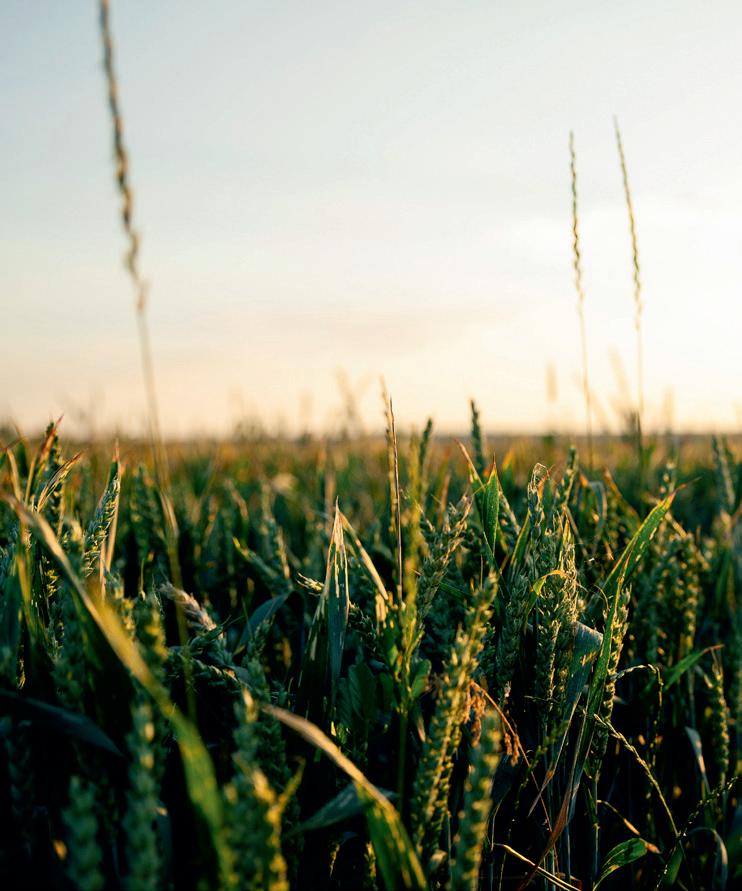
Precision breeding in plants create new varieties that can contribute significantly to solving sustainability and climate challenges.
33 PRODUCING MORE WITH LESS
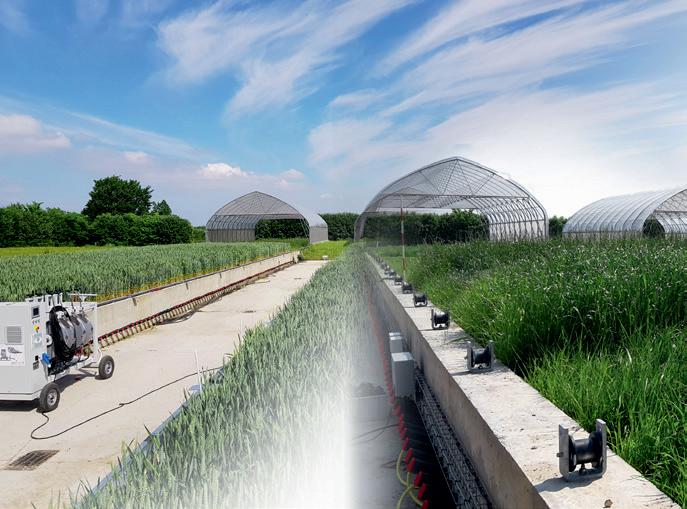
Addressing the root cause of resilient crops
Together with the University of Copenhagen, DLF is testing the root architecture of crop varieties at the world's most advanced root screening facility, RadiMax. It enables imaging of roots down to three metres depth and at the same time, the grasses can be exposed to increasing drought conditions through a soil moisture gradient, which can be induced in the system. This makes it possible to screen the root architecture of our varieties and find out which ones can perform under drought conditions.
RadiMax can test up to 600 plant lines simultaneously in its four 10×40 m V-shaped pits. All of them are equipped with a unique irrigation system, designed by computer simulation to generate the most efficient selection system for deep rooting. In support of this selection, more than three kilometres of plexiglass tubes provide visual access for multispectral cameras imaging the root profiles of each single line.
For the first time it has become possible to uncover the hidden world of root growth at a breeding scale and relate it to the most pertinent climate threat, namely drought. Since the first screenings were conducted in 2016, DLF has been able to supply forage and turf customers with varieties, having verified deep rooting and superior drought stress tolerance. Through this facility, DLF has identified varieties with 30 percent deeper root mass and correspondingly better drought tolerance.
CONTRIBUTORS
DLF
University of Copenhagen
CASES 34
Photo credit: DLF
The need for robust, drought-tolerant crops and grasses has never been greater than now. This is the main focus of the RadiMax facility.
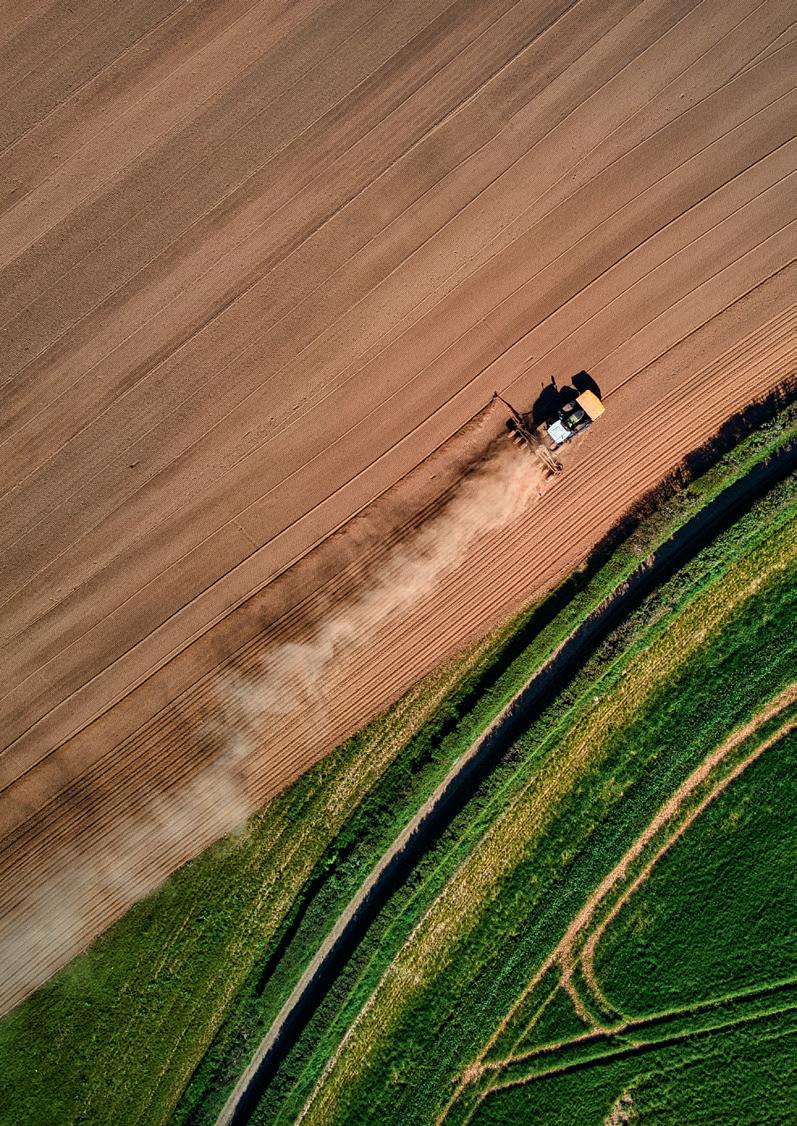
35 PRODUCING MORE WITH LESS
Learn more about green agrifood solutions, find cases from around the world and connect with Danish experts at: stateofgreen.com

STATE OF GREEN IS A NOT-FOR-PROFIT, PUBLIC-PRIVATE PARTNERSHIP FOUNDED BY:


 Morten Bødskov Minister for Industry, Business and Financial Affairs
Morten Bødskov Minister for Industry, Business and Financial Affairs
 Merete Juhl CEO of the Danish Agriculture and Food Council
Merete Juhl CEO of the Danish Agriculture and Food Council



















